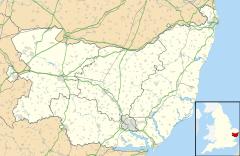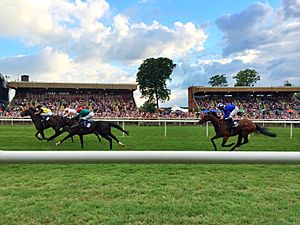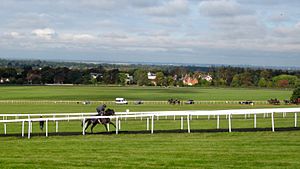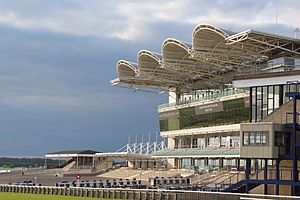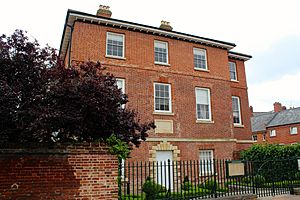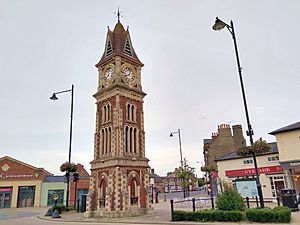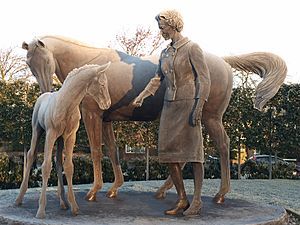Newmarket, Suffolk facts for kids
Newmarket is a historic market town in Suffolk, England. It's about 14 miles west of Bury St Edmunds and 14 miles northeast of Cambridge. In 2021, about 16,772 people lived there. Newmarket is known around the world as a major center for thoroughbred horse racing. This means it's a very important place for training racehorses, breeding them, and keeping them healthy. Each year, two of the most important horse races in the UK, called Classic races, happen here. Newmarket has been connected to the royal family since the time of King James I, who built a palace in the town. Many kings and queens, including Queen Elizabeth II, often visited Newmarket to see their horses train.
Newmarket has more than fifty stables where racehorses are trained. It also has two big racetracks, the Rowley Mile and the July Course. The town is home to over 3,500 racehorses, and it's thought that one out of every three jobs in Newmarket is linked to horse racing. You can find the National Heritage Centre for Horseracing and Sporting Art at Palace House, the National Horseracing Museum, and Tattersalls, a famous place where racehorses are sold. There are also two of the world's best hospitals for horses in Newmarket. The town is surrounded by over sixty places where horses are bred, called studs. Because of its important role in the huge horse racing and breeding industry, Newmarket is also a major center for exporting horses.
Quick facts for kids Newmarket |
|
|---|---|
| Town | |
 A view of Newmarket showing horses galloping up part of the Long Hill training grounds |
|
| Area | 14.65 km2 (5.66 sq mi) |
| Population | 16,772 (2021 Census) |
| • Density | 1,145/km2 (2,970/sq mi) |
| OS grid reference | TL645636 |
| Civil parish |
|
| District |
|
| Shire county | |
| Region | |
| Country | England |
| Sovereign state | United Kingdom |
| Post town | NEWMARKET |
| Postcode district | CB8 |
| Dialling code | 01638 |
| Police | Suffolk |
| Fire | Suffolk |
| Ambulance | East of England |
| EU Parliament | East of England |
| UK Parliament |
|
Contents
- History of Newmarket
- Newmarket's Location and Local Government
- Newmarket: The Home of Horse Racing
- Food and Drink in Newmarket
- Culture and Community
- Getting Around Newmarket
- Education in Newmarket
- Media and News
- Sports and Fun Activities
- Healthcare in Newmarket
- Famous People from Newmarket
- Twin Towns
- Images for kids
- See also
History of Newmarket
How Newmarket Got Its Name
Newmarket's name was first written down in Latin as Novo Mercato in 1219. This means "New Market," showing that it was a place where people came to buy and sell things. In 1223, a man named Richard de Argentein was given permission to hold a yearly fair in Newmarket.
Royal Connections and the Palace
King James I first visited Newmarket in February 1605. He thought it was a "poor little village." But from 1606 to 1610, he built the Newmarket Palace. This palace covered about 1 acre of land and made the town a special place for the royal family to visit. This also helped Newmarket become a famous horse racing town.
The first palace building had problems and started to sink on one side in 1613. So, new buildings were ordered for the King and the Prince of Wales. These new parts of the palace were designed in an Italian style and had three floors.
Newmarket During the English Civil War
In 1642, King Charles I met with a group from Parliament in Newmarket. They demanded that he give up control of the army. King Charles I refused, saying, "By God not for an hour!" This meeting effectively started the English Civil War. Newmarket stayed loyal to the King during the war.
In June 1647, King Charles I was captured and brought to Newmarket as a prisoner. He was kept under house arrest in the palace, and Oliver Cromwell's army guarded the whole town. After the war, in 1649, the palace was in bad shape. The next year, it was sold and most of it was torn down.
Charles II and Later Royal Visits
Between 1666 and 1685, King Charles II often visited Newmarket. In 1668, he asked for a new palace to be built on the High Street. However, in 1670, someone described it as "meane enough," meaning it wasn't very grand for a royal palace. Later, in 1677 and 1695, William of Orange also visited Newmarket.
A Royal Horse Racing Scandal
In 1791, the Prince of Wales (who later became King George IV) had a horse named Escape. The horse lost a race, but then won another race the very next day. This made people suspicious that the first race might have been lost on purpose to get better betting odds. The people in charge of the Jockey Club told the prince that if he kept the jockey, no one else would race against him. The prince decided to stop racing altogether and sold his horses. He never returned to Newmarket for races.
Newmarket's Growth and Modern History
By the early 1800s, most of the old palace was gone, but a part of it still stands today and is called Palace House. During the 1800s, Newmarket grew south of the High Street, spreading into nearby areas that were in a different county, Cambridgeshire. In 1894, the county border was moved to include these new parts of Newmarket in Suffolk.
In 1977, a jet fighter plane crashed near Newmarket due to a problem with its hydraulics. In 2012, a British TV show called Time Team dug up the site of Charles II's palace in Newmarket. They found the foundations of stables where racehorses were kept.
Newmarket's Location and Local Government
Newmarket is in a part of Suffolk that is almost separated from the rest of the county, with only a small strip of land connecting it. The town has three levels of local government:
- Newmarket Town Council (for the town itself)
- West Suffolk District Council (for the wider district)
- Suffolk County Council (for the whole county)
The town is part of the West Suffolk area for Parliament. Since 2024, Nick Timothy has been the Member of Parliament (MP) for this area.
How Newmarket's Borders Changed
Historically, Newmarket was split between two different parishes and two counties. One part, St Mary, was in Suffolk, and the other part, All Saints, was in Cambridgeshire. The border between them ran right through the middle of the town, along the High Street.
Over time, these borders changed. In 1889, the whole area of Newmarket was brought into West Suffolk. Later, in 1894, Newmarket became an Urban District, which meant it had its own council to manage the town. The Newmarket Urban District Council was given a special coat of arms in 1951.
In 1974, the Newmarket Urban District Council was ended. Newmarket then became part of a larger district called Forest Heath District. In 1999, the area was split into two new parishes, Newmarket and Exning, and the Newmarket parish council became the Newmarket Town Council.
Newmarket: The Home of Horse Racing
Horse racing in Newmarket dates back as far as 1174, making it one of the oldest known racing places. King James I (who ruled from 1603 to 1625) made horse racing much more popular here. King Charles I then started the first cup race in 1634. The Jockey Club, which is a very important organization in horse racing, has its clubhouse in Newmarket.
Horse Stables and Training
Around 3,000 racehorses live in and near Newmarket. The town has about 15,000 people, and it's believed that one in three jobs are related to horse racing. Newmarket has three main areas of open land, called "Heaths," which are used to train the racehorses. The grass on these training grounds has been carefully looked after for hundreds of years and is considered some of the best in the world.
- Racecourse Side is next to the Rowley Mile Racecourse and is mostly flat.
- Warren Hill looks over the town and has special tracks for horses to gallop on, both all-weather and grass.
- Bury Side is near the Bury Road and the railway line.
These areas are made of chalk downland, which is a special type of land that has unique birds and animals. It's also a historical area with signs of people living there in the 6th century. Newmarket has about 50 miles (80 km) of grass tracks and over 14 miles (23 km) of artificial tracks for training.
Most of the racing stables in Newmarket are in the center of town, so horses can easily get to the training grounds. The town even has special paths for horses to safely reach the gallops from their stables. Many of the world's most successful horse trainers are based in Newmarket, like Sir Michael Stoute, John Gosden, Saeed bin Suroor, and Charlie Appleby. These trainers win millions of pounds in prize money around the world each year. Many of the horses they train are worth over £1 million, and some of the best can be worth between £5 million and £50 million or even more! Outside the town, the land is mostly used for breeding thoroughbred horses, with many stud farms in every direction. About seventy licensed trainers and more than sixty stud farms work in and around Newmarket.
Horse Racing Events
Newmarket has two racecourses on Newmarket Heath: The Rowley Mile and The July Course. The Rowley Mile is where Newmarket's two Classic races are held: the 2,000 Guineas and the 1,000 Guineas. These are two of the most famous races in the world and happen on the first weekend of May every year. Winning these races can make a horse's value increase by millions of pounds right away. The Rowley Mile also hosts Future Champions Day, which includes the important Dewhurst Stakes. The July Course is home to the July Cup, the Falmouth Stakes, and other important races. The two courses are separated by the Devil's Dyke, a large earthwork that is over 7 miles (11 km) long.
Horse Breeding Industry
Newmarket is the main center in the UK for the huge racehorse breeding industry, which is worth billions of pounds. It's also a key global center for this business. Breeding the right horses is very important for success in horse racing around the world. Major breeding companies own large areas of land around the town where they have their stud farms.
For example, Darley Stud, which owns famous horses like New Approach and Dubawi, has large areas of land south of the town. Shadwell Stud and Juddmonte Farms, which owns Frankel, also have big stud farms nearby. Cheveley Park Stud and Lanwades Stud are also based next to the town. In 1967, Queen Elizabeth II opened The National Stud, which is a special breeding center for thoroughbred horses. Many of the world's largest and most successful horse breeding studs are located around Newmarket.
Museums of Horse Racing
Newmarket is home to Britain's National Heritage Centre for Horseracing and Sporting Art at Palace House. It also has the National Horseracing Museum and a base for Retraining of Racehorses, which helps retired racehorses find new homes and careers.
Food and Drink in Newmarket
Newmarket Sausages
Newmarket is famous for its special sausages, called Newmarket sausages. These sausages have been made since the 1880s. Only three local butchers in the town are allowed to make these unique sausages with their special flavor. The Newmarket sausages are even given as a prize for the Newmarket Town Plate, a horse race held every year at Newmarket racecourse.
Culture and Community
Because Newmarket has been so important in sports for many centuries, it has become a center for many of Britain's best sports painters. In the early 1700s, painting about sports became popular, especially around the Newmarket Racecourse. Famous painters like John Wootton and James Seymour painted many scenes of the racecourse and the area around it. Newmarket is also the setting for some of Sir Alfred Munnings's most famous paintings.
A group called "Save Historic Newmarket" works to protect the town's special history as the world headquarters of racing. This group wants to make sure that Newmarket grows in a way that keeps its unique heritage. They also want to make Newmarket a more attractive place for visitors.
Getting Around Newmarket
Newmarket railway station is on the Ipswich-Ely railway line. Newmarket's first railway line opened in 1848. It connected Newmarket to Great Chesterford. However, a few years later, a new section of track was built that linked Newmarket directly to Cambridge, and the old section was closed. The original Newmarket station was replaced by the current station in 1902.
A short distance northeast of the town is the 1,100-yard Warren Hill tunnel. North of the tunnel, a separate station called Warren Hill was built just for use on race days.
Regular bus services connect Newmarket to nearby towns like Bury St Edmunds, Cambridge, Ely, and Mildenhall. There are also National Express coach services that serve the town, connecting it to major cities and airports like London, Norwich, Stansted, Heathrow, and Gatwick.
Education in Newmarket
Newmarket has several primary schools. After primary school, students go to Newmarket Academy, which is the town's only secondary school for students aged 11 to 18. The town also has an Air Training Corps Squadron (2417 Newmarket Squadron) and an Army Cadet Detachment, which are youth organizations.
Media and News
Local news and television programs for Newmarket are provided by BBC East and ITV Anglia. You can also listen to local radio stations like BBC Radio Suffolk and BBC Radio Cambridgeshire, as well as Heart East, Star Radio, and Greatest Hits Radio Cambridgeshire. The local newspaper for the town is the Newmarket Journal.
Sports and Fun Activities
Newmarket has two racecourses, The Rowley Mile and The July Course, and is home to 3,000 thoroughbred racehorses and over 70 racehorse trainers. The local football team is Newmarket Town. In the 2005–06 season, the club reached the quarter-finals of the FA Vase, which is a national football competition. Newmarket Hockey Club plays field hockey, and Newmarket Cycling and Triathlon club is a group for people who enjoy cycling in the town.
A greyhound racing track used to be open near the Cricket Field Road ground, where Newmarket Town FC plays. This track was active after World War II and in 1967.
Healthcare in Newmarket
The Rous Memorial Hospital (1870s–1966)
In 1866, people started a campaign to build a small hospital in Newmarket. In 1878, the Jockey Club raised £5000 to honor Admiral Rous. In the 1900s, it became a unit led by general practitioners (GPs). In 1977, it was changed into almshouses, which are homes for elderly or poor people.
Famous People from Newmarket
Newmarket has been home to many famous people, especially in horse racing. These include well-known jockeys like Frankie Dettori, William Buick, Ryan Moore, and Tom Queally. Famous trainers who have lived here include Sir Michael Stoute, John Gosden, James Fanshawe, Saeed bin Suroor, Charlie Appleby, and Marco Botti. Former West Indian cricketer Michael Holding also lived in Newmarket.
Many wealthy owners of racing stables and stud farms have also lived in Newmarket, such as David Robinson and Lester Piggott.
Newmarket is also the birthplace of:
- William Thomas Tutte (1917–2002), a mathematician and World War II cryptoanalyst (someone who breaks secret codes).
- Thomas Elsdon Ashford (1859–1913), who received the Victoria Cross (a very brave award) during the Second Anglo-Afghan War.
- Ross Edgar (born 1983), who won a Silver Medal in cycling at the 2008 Olympics.
- Dina Carroll (born 1968), a singer who won a Brit Award.
- Jamie Paul "JJ" Hamblett (born 1988), a singer from the band Union J, who used to work for Newmarket trainer John Gosden.
Twin Towns
Newmarket is twinned with several towns around the world, which means they have special friendly relationships:
Images for kids
-
How to Escape Winning by Thomas Rowlandson. Escape's legs are bound by the motto of the Order of the Garter, and his jockey is shown holding him back.
See also
 In Spanish: Newmarket para niños
In Spanish: Newmarket para niños


